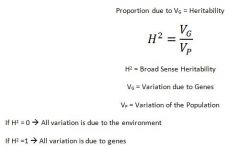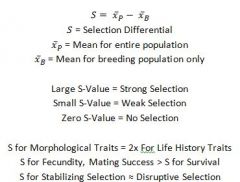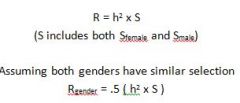![]()
![]()
![]()
Use LEFT and RIGHT arrow keys to navigate between flashcards;
Use UP and DOWN arrow keys to flip the card;
H to show hint;
A reads text to speech;
40 Cards in this Set
- Front
- Back
|
Broad-Sense Heritabiltiy
|

|
|
|
Narrow-Sense Heritability
|

|
|
|
Types of Selection
|
Directional, Stabilizing, Disruptive
|
|
|
Strength of Selection for a Trait
|

|
|
|
Evolutionary Response of a Population
|

|
|
|
Phenotype Plasticity
|
Variation in genetic expression due to the environment
|
|
|
Full Trait Variance Equation
|

|
|
|
Epistasis
|
One gene controls expression of another
|
|
|
Quantitative Genetics
|
Study of evolution of continuous phenotypes
|
|
|
Quantifiable Phenotypes Exhibit:
|
Mean
and Variance |
|
|
The "40-Year-Old" Daphne Major Study
|
-Very small volcanic island, near Galapagos
-Very isolated -Peter and Rosemary Grant measured changes over 40 years. Evolution is clearly happening, because allele frequency is changing over time. |
|
|
Hopi Hoekstra's "Oldfield Mouse" Experiment
|
-Used clay mice to see what predators prefer in the different zones
-Population is experiencing disruptive selection, because the two alleles are being selected for at the same time, but in different places -Geographic comparison shows the same trend, but different genes involved, therefore convergent evolution has occurred. |
|
|
Geneflow
|
Migration of alleles from one population to another
|
|
|
Mechanisms of Geneflow
|
Migration, Pollination, Attached-Transfer, Vector-Transfer
|
|
|
Kingsnake Selection Study
|
Kingsnake uses Batesian mimicry to copy the more dangerous Coral Snake (who is using aposematic coloration as a warning)... However, the southern alleles do not spread north because the dominant black band of the southern kingsnake does not scare predators.
|
|
|
Goldenrod Galls
|
Alter plant expression to create a home and food... This is an "extended phenotype" ... Something that directly relates back to the organism (and it's phenotype) but is not part of the organism itself.
-Galls experience stabilizing selection, because too large or too small are eaten. |
|
|
Other examples of Extended Phenotype
|
Birds' nests, Spiders' webs, Caddisfly Larvae's BLING
|
|
|
Seed-Dispersal Methods
|
Dehiscence -- Pod splits, ruptures, and seeds explode away
Shedding -- Seeds blow away or drop to the ground |
|
|
Selective Breeding of Wheat
|
Humans have been unknowingly selecting for non-shattered wheat because it's easier to collect. This made wheat easier to harvest over time.
|
|
|
Other examples of Selectively-Bred Plants
|
Wild Mustard Plant -- broccoli, cauliflower, brussel sprouts, and cabbage
Sunflower Seeds Tomatos |
|
|
Resistance Evolves...
|
Resistance evolves under selection for alleles that detoxify or prevent entry.
|
|
|
San Jose Scale
|
One of the first noted examples of pesticide resistance.
|
|
|
Habitat Alteration (and URBANIZATION)
|
Increased pavement and less green space
-Impact on Plants -Invasive Species Introduced |
|
|
Example of Invasive Species
|
Zebra Mussel, Kudzu
|
|
|
Hunting and Fishing
|
Causes directional selection, because all of the biggest and healthiest are killed as game. This leaves only the smallest and weakest to reproduce, which is really bad for the population health
|
|
|
Waterfoul Sex (specifically muscovy duck)
|
Cloacas/Penis/etc.
Males are counter clockwise Females are clockwise... results in sexual conflict... Males more successful if they court females, making them receptive to THE WHOLE PENIS |
|
|
Types of Sexual Selection
|
Intrasexual Selection -- Competition between males, competition between females
Intersexual Selection -- Adaptations that promote mating or promote some behavior related to mating/courtship/etc |
|
|
Why is SEX beneficial?
|
-Genetic Variation
-Combines beneficial mutations -Removes deleterious mutations -Faster evolution -Allows for co-evolution and complex relationships |
|
|
"Red Queen Effect"
|
In order to survive (stay) a species must evolve (run)
Ex: Predator/Prey Populations, such as snowshoe hair and lynx |
|
|
What is the one huge advantage that asexually reproducing organisms possess?
|
SPEED OF REPRODUCTION, AND THEY DO NOT REQUIRE A MATE
|
|
|
What was important about the New Zealand Snails?
|
Trematodes were causing some degree in both asexual and sexual populations; turns out the sexual population naturally has higher fecundity, probably because they're already adapting to the trematode issue.
|
|
|
What was important about the Bdelloid Rotifers?
|
they are asexual organisms that do not need sex, because of their cryptobiotic mechanisms which allow them to survive almost any conditions... They aren't affected by pathogens, so they have no need to adapt. Sex isn't necessary. However, they do ingest some foreign DNA during repair...
|
|
|
Dimorphic differences in relative investments between the two sexes
|
Anisogamy -- Unequal Gamete SIZE/COST
Limits on fecundity -- females have limited number of eggs/ males are limited by access to females |
|
|
Examples of sexual dimorphism:
|
Robins (male = red breast; most birds are this way)
Spiders (females MUCH larger for egg sac) Siamese Fighting Fish (Males decorated highly) Jawfish (Male holds eggs in mouth) Gypsy Moth (Females wait, secrete hormones, males seek) |
|
|
Fecundity increases in females that...
|
Exhibit male choice...
And... Invest in parental care... |
|
|
Fecundity increases in males that...
|
Gain access to more females...
and... Ensure paternity... |
|
|
Male Phenotypic tricks to gain better access to THE LADIES
|
Territorialism in Dung Flies
Courtships in Manakin Birds Resource provisioning in Catydids/Praying Mantis Forced Copulation |
|
|
Male Phenotypic tricks to ENSURE BABY DADDY
|
Mate Guarding in Damselfly
Sperm competitions in Weevil beetle Male parental care in Seahorse |
|
|
Polyandry
|
One female seeks out MANY male mates...
-Ensures some of the offspring will have fitness benefits -Increases variation of offspring |
|
|
Female Mate Choice
|
-Females that are choosy attain higher fitness
|

